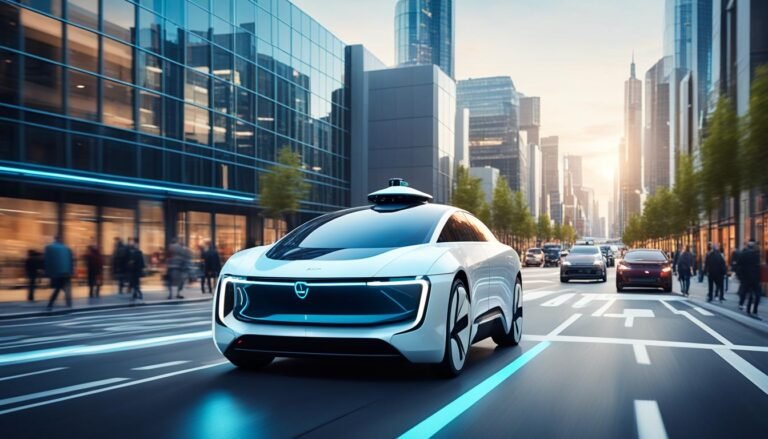How Autonomous Vehicles Are Impacting Transportation
Are we on the brink of a transportation revolution destined to surpass even the invention of the automobile?
The evolution of autonomous vehicles (AVs) is changing how we see mobility. It’s disrupting traditional transportation systems and shaping urban and regional development. Soon, vehicles will drive themselves, making roads and highways smarter.
Already, about 3% of U.S. vehicles have self-driving features. This number is expected to jump to 92% by 2030, according to Lux Research. Companies like Rio Tinto are leading the way with self-driving ore trucks. They plan to grow their fleet a lot.
As automated mobility grows, it could cut accidents by over 90%. This could save the economy up to $300 billion a year. Also, AVs could make fuel use 25% better by driving more efficiently.
Key Takeaways
- By 2030, 92% of U.S. vehicles are expected to have self-driving features.
- Autonomous vehicles could save the economy $300 billion annually by reducing driver-error accidents.
- Fuel economy improvements of up to 25% are possible with AVs.
- Dedicated lanes or infrastructure investments may be necessary for optimal AV utility.
- Self-driving technology can dramatically change urban and suburban landscapes.
The Development and Advancement of Autonomous Vehicles
Autonomous vehicles have grown a lot in the last few years. More self-driving cars and driverless vehicles are hitting the roads. This growth is thanks to new tech and the hard work of big players in the field.
Milestones in Autonomous Vehicle Technology
Autonomous vehicles have made huge strides since the 1920s. Now, we have advanced tech like LiDAR, cameras, and radar. These tools help AVs see and react to their surroundings quickly.
These advancements have greatly improved AV safety. They aim to cut down on accidents caused by human mistakes.
Key Players in the AV Market
Some companies are leading the way in autonomous vehicles. Mercedes, Audi, Google, and Tesla are at the top. They’re spending a lot on testing and using AVs in different places.
This competition is driving them to keep improving. They want to stay ahead in the race for the best AV tech.
Government Regulations and Policies
Rules for autonomous vehicles are key to making them work well with our traffic. Governments in the U.S. and the U.K. are making laws to help. These laws aim to keep things safe while letting AVs grow.
They also work on making roads better for AVs. This includes improving how cars talk to each other and the roads. It’s all about making traffic safer and smoother.
In short, the growth of autonomous vehicles is thanks to tech, leaders, and rules. Together, they’re shaping a future where travel is safer and more efficient.
Autonomous Vehicles and Enhanced Safety
Autonomous vehicles, or AVs, are changing road safety with new technologies. They use advanced systems to cut down on accidents. These vehicles follow rules and react fast to improve road safety.
Reduction in Traffic Accidents
AVs are making roads safer by reducing accidents. In 2022, over 42,000 people died in car crashes. This shows we need better safety in cars.
Waymo’s cars have driven 20 million miles safely. Tesla’s Autopilot has logged over 3 billion miles. These numbers show how AVs can save lives and reduce injuries.
AVs can also stop accidents caused by distracted driving or drunk driving. They offer more freedom for seniors and people with disabilities. This makes roads safer for everyone.
Challenges in AI and Safety Measures
But, AVs face challenges like bad weather and unique road situations. Ford tested AVs in snow to learn how they handle it.
Studies like the one by McKinsey & Company are working on these problems. They aim to make AI systems reliable and safe. This involves better algorithms, sensors, and data.
As AVs get better, they could make roads much safer. They could save money and make travel more efficient. The future of driving looks promising with AVs.
| Aspect | Current Statistics | Potential Impact |
|---|---|---|
| Miles Driven by Waymo | 20 Million | Reduction in Traffic Accidents |
| Miles Driven by Tesla’s Autopilot | 3 Billion | Enhanced Road Safety |
| Annual Motor Vehicle Crash Cost | Billions | Economic Savings |
| Time Spent in Traffic Delays (2014) | 6.9 Billion Hours | Increased Efficiency |
Environmental Impact of Self-Driving Cars
Autonomous Vehicles (AVs) have both good and bad sides for the environment. We need to look at how they affect emissions, fuel use, and the role of electric cars. We also have to think about the possible downsides.
Emission Reduction and Fuel Efficiency
AVs could greatly reduce emissions. The transport sector uses a lot of oil, leading to a big share of greenhouse gas emissions. About 30% of these emissions come from cars and trucks.
AVs can use less fuel by driving more efficiently. For example, platooning can cut energy use by 3% to 25%. This makes AVs a good choice for reducing emissions.
Potential Negative Environmental Effects
AVs might also have some bad effects. They could lead to more driving, which might cancel out some of the good they do. Also, their complex systems might use more energy and increase emissions by 3% to 20%.
Role of Electric Vehicles
Electric AVs are key to making AVs better for the environment. But, they need a lot of energy to run. Using clean energy sources like wind and solar can make them much greener.
By 2025, 20% of new cars might be electric. This shows how important electric AVs are for a green future.
The link between AVs and electric cars is crucial for the future of transport.
| Aspect | Impact |
|---|---|
| Emission Reduction Potential | Up to 25% with optimized driving patterns |
| Primary Energy Use Increase | 3% to 20% due to AV system power requirements |
| Projected Electric Car Sales by 2025 | 20% of all new cars sold globally |
| Renewable Energy Use (2021) | 38% of the world’s electricity |
How Autonomous Vehicles Are Impacting Transportation: Urban and Suburban Changes
The rise of autonomous vehicles (AVs) is changing urban and suburban areas a lot. The impact of AVs on urban design means we need to rethink our current setup.
Impact on Urban Infrastructure
City planners are now thinking differently about urban layouts with AVs. AVs mean less need for parking, which opens up a lot of space for other uses. Adding smart traffic signals and special AV lanes is key for better city travel.
Also, electric AVs mean less need for fuel stations, making cities greener.
Self-driving cars use less energy, cutting down on pollution. By 2040, half of all road travel could be by AVs, says *CNBC*. This shows we need to update our infrastructure fast.
Effects on Public Transit and Traffic Management
The mix of autonomous vehicles and public transit brings both chances and hurdles. More people using AVs might mean fewer on public transit. We need to adapt transit systems to this change.
Using both human-driven and self-driving vehicles can help. Shared AV rides could also ease traffic, make roads safer, and help those who can’t afford cars. AI can make public transport better by giving real-time updates and personalized services.
Suburban Sprawl and Real Estate Dynamics
AVs are making suburbs more appealing, leading to more growth. This could change how we value properties in different areas. The link between real estate and AV technology is clear, as garages might turn into other spaces with shared AVs.
This change opens up new chances for real estate and urban planning. It’s a big shift in how we think about cities.
As AV tech keeps improving, we need everyone to work together. This includes policymakers, planners, and tech companies. By planning well, improving infrastructure, and focusing on sustainability, we can make cities better for everyone.
Sociological and Economic Influences of AVs
Autonomous vehicles are changing society and the economy in big ways. They offer new mobility for the elderly and those with physical challenges. This changes how we use transportation.
AVs also promise to make roads safer. Experts say they could cut crashes by 33% to 90%. For example, a 1% drop in crashes could save over $8 billion in the US each year.
From an economic view, AVs bring big benefits. They could cut transportation costs by almost half. This makes them a cheaper option than traditional public transport.
In the logistics and transport sectors, AVs make supply chains more efficient. They also help use assets better. This is important because today’s vehicles cost about $0.82 per mile to run. AVs could lower this cost.
AVs also save a lot of money by reducing road crashes. In 2010, crashes in the US cost $836 billion. This includes $242 billion in economic damage and $57.6 billion in lost productivity. AVs could greatly reduce these costs.
AVs might also change how we live in cities and how we move around. Research shows they could cut traffic congestion. But, more studies are needed to understand their full impact on society.
As we use digital tech more in transport, our time in public transit changes. Studies show trains could become mobile offices. This changes how we use our free time during commutes.
Finally, AVs could greatly reduce traffic costs. In the Netherlands, these costs were around EUR 3.3 to 4.3 billion in 2018. AVs could make moving goods faster, helping the economy. But, they might also lead to more miles driven, which could cause more traffic.
Conclusion
The Future of Transportation is changing fast, thanks to autonomous vehicles. From Google’s early work to Uber and Volvo’s partnerships, we’re seeing big steps forward. These self-driving cars could change how we travel, making it safer, more efficient, and better for the planet.
One big benefit is fewer accidents. Since most crashes are caused by human mistakes, self-driving cars could save thousands of lives. They also promise to make deliveries faster and easier, and help people with disabilities and the elderly move around more easily.
But, there are still big challenges to overcome. We need to make sure these cars work well in all situations and that laws are in place to keep everyone safe. It’s a team effort from governments, tech companies, and the public to make self-driving cars a reality. They could change how we travel, live, and interact with our environment in big ways.
Source Links
- Time for Autonomous Vehicles to Disrupt Transportation Planning – The Eno Center for Transportation
- How Autonomous Vehicles Will Influence Transportation of the Future
- Autonomous Vehicles: The Impact on Transportation & Logistics
- Advanced research in autonomous vehicles | Automotive Articles
- Autonomous Vehicles Factsheet
- Automated Vehicles for Safety | NHTSA
- Environmental Pros and Cons of Self-Driving Cars | Earth.Org
- 7 Unbelievable Benefits of Self-Driving Cars You Can’t-Miss
- Reshaping Cities: How Autonomous Cars Impact Urban Life | TechAhead
- How Self-Driving Cars Are Changing Public Transportation Laws
- Assessing the Impacts of Autonomous Vehicles on Urban Sprawl
- Social implications of autonomous vehicles: a focus on time
- The economic and social impacts of fully autonomous vehicles – Compact
- How Autonomous Vehicles Are Shaping the Future
- Issue Brief | Autonomous Vehicles: State of the Technology and Potential Role as a Climate Solution | White Papers
- Exploring the implications of autonomous vehicles: a comprehensive review








